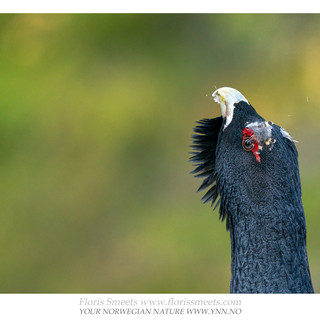CAPERCAILLIE LEKKING SEASON 2020
- florissmeetsphotog
- May 18, 2020
- 10 min read

With mixed emotions I went through this year’s grouse lekking season. Due to the COVID-19 situation, all bookings for my black grouse and capercaillie hides were cancelled. Since the grouse season accounts for a large part of my yearly income, I was stressed out and was feeling quite down in the start of the season. Luckily, I decided to prepare the season just like any other year. I set up a few hides on the leks and placed camera traps on the capercaillie lek to keep track of the activity. When in early April I went to check the camera traps for the first time, I didn’t expect to see much yet. To my big surprise, the birds had already started to show themselves regularly in the lek center from the end of March. Normally this doesn’t happen until the second week of April. Once I saw these images, I got excited and realized that I had all the time and freedom to photograph myself this year. Something I have not had for the past 6 years. I decided to make the best out of a bad situation and try to get some images I have dreamed about for the past 10 years.

A male capercaillie at the lek center on the 31st of March.
The capercaillie lek I use, spreads out over an area of about 400 by 300 meter. The number of males using the leks varies from year to year, depending on the population size. The lowest number of adult males was 4 and in the best year we counted over 10 adult males. It is difficult to say if there were 11 or 12, because you never get to see them all at the same time. In the middle of the lek there is a small piece of open pine forest, right on top of a small hill. This has been the lek center for most of the years. But last year things changed. The dominant male died and no other male dared to take over the center. There were 4 males which were mainly displaying around the center and sometimes one of them dared to show himself there. Even when the females started to arrive in the center, none of the males came out to claim them. As a result, the females spread out over the lek and several males got to mate.
For this year I hoped that one male would take over the lek again and collect all the females in the lek center. This place is by far the best for back-light and the background is far and clean. When I saw on the camera trap that 1 male showed himself every day right in the lek center, I assumed that he would be the new boss. But after having spent the first night on the lek and seeing this male in real life, I quickly realized that this bird would be too young to take over the lek.
The younger male which displayed in the lek center.
Sony a9II and Sony 400mm f2.8 at 400mm, f2.8 at various ISO and shutter speed values
I could hear several other males displaying around the lek center. One seemed most active and displayed in an area where I never have had any hides set up before. I tried to figure out about where the bird would be displaying and put up another hide. A few days later I tried my luck, but the male I had heard before, didn’t show up. I could hear several other birds displaying but it remained quite around my hide. Again, one male in particular seemed to be more active that the others. Through a tiny opening between the many trees, I managed to catch a short glimpse of this bird. Zoomed in 100% on live-view mode, I could see that this bird had a much longer tail than the bird I photographed in the lek center and could also see that he was missing one tail feather.
When the display was over for the day, I tried to find the exact spot where this bigger male was displaying. To my big surprise, the bird had chosen a spot just outside the dense forest, in an old clear-cut. The place was completely open and exposed, which is rather strange. Birds of prey would easily be able to spot him from a long distance. Because it seemed so odd that the bird was displaying there, I first put up a camera trap to see if he would be back on the same spot the next day.
The next day the weather forecast predicted a clear sky. Since I have never been able to photograph the capercaillie with good back light, I decided to go back to the lek center to the hide which I had placed for back light. Almost two hours before sunrise I got woken up by the younger male displaying in the center. He was a bit too far to my right but slowly worked his way towards my hide.

The younger male.
Sony a9II and Sony 400mm f2.8 at 400mm, f2.8, ISO 3200, 1/100s
There was still plenty of time until sunrise, so no stress. Suddenly I could hear a female capercaillie fly in. It sounded like she landed exactly at the hide I was in the day before. Carefully I opened one of the openings on the backside of the hide and managed to spot the female. It didn’t take long until a large male showed up there and also a second female. …right in front of the hide I was the day before. When the male turned, I directly recognized him. ….one tail feather was missing. It was the male I spotted in the far distance the day before. So typical that they were there when I was in the other hide. And to make things worse, the younger male didn’t dare to come all the way out on to the open spot. He kept himself to my far-right side.

The younger male.
Sony a9II and Sony 400mm f2.8 at 400mm, f2.8, ISO 4000, 1/80s
In the meantime, the sun had come up and I had the most beautiful light right in front of me, but no bird to photograph. I just sent a text message to my girlfriend to let her know that everywhere there was a lot of action, except in front of my hide, when another female arrived on the lek. This time right behind my hide. The big male suddenly rushed over to pick her up. This completely scared off the younger male and he also scared off the female. Now I had this big male right behind my tent and no clue anymore where the females were, until one of them landed behind the hill in front of me. The big male quickly rushed over the hill and disappeared out of my sight. I could hear him clearly, but just couldn’t see him. I don’t know how often I said in my mind, “please please please come up the hill”, when I spotted the tip of his beak sticking out from behind the hill.

My first shot of the big boss of the lek.
Sony a9II and Sony 400mm f2.8 at 400mm, f2.8, ISO 1600, 1/1000s
Before I knew it, a female walked up the hill and the big male followed. Luckily the sun wasn’t up that long yet, so the back light was still good. For about 5 minutes the two birds were right in front of my hide and I could get the shots I was after. Some of the females appeared again at the other hide and the two birds disappeared in that direction.
A female appeared and the big male quickly followed.
Sony a9II and Sony 400mm f2.8 at 400mm, f2.8 at various ISO and shutter speed values
After it had gone quiet on the lek, I checked the camera trap at the clearing. I didn’t expect to see much because I assumed that the big male mainly would have displayed in the forest around the other hide. Once again I got surprised. The camera trap showed that the male started to display there and returned there after having collected all the females on the lek. It seemed like that this would be the new lek center.
The big boss collecting his females before sunrise and appearing back at the same spot some hours later.
Setting up a hide at this spot was not that easy, due to the fact that it was on a slope some trees standing at exactly the wrong spots. Because the spot was on a slope, it was very important to have the hide standing at the right angle to the birds. You don’t want to be photographing down on the birds. And in this case, also not too much up because of some tiny snow hills coming in between the birds and the camera. In the end I managed to find an opening between two trees which was big enough for my hide and where the slope was not too steep. Also the angle seemed to be good with a nice clear background. Only the distance seemed a bit questionable. It seemed a bit close for using a 400mm lens. So I decided to also bring a 70-200mm on a second body.
That night I could barely sleep. I was so excited about what was about to come and was wondering if the male would disappear again into the forest, like he did the day before. Two hours before sunrise I could hear how the male capercaillie started to display in front of my hide. I was so afraid to make any sounds, that it took me about 30 minutes to get out of my sleeping bag and onto my chair. In the meantime the first females had arrived. When I finally got my first peek outside, I could barely believe my eyes. There they were. The big male with 6 females around him. It was still pretty dark, but I carefully started to take the first images. While the light started to get better and better, more females arrived and the spot started to get more attention from the other males on the lek.
1st image: Sony a9 and Sony 70-200mm f2.8 at 198mm, f2.8, ISO 1000, 1/640s
Other images: Sony a9II and Sony 400mm f2.8 at 400mm, at various apertures, ISO and shutter speed values
The other males were clearly no match for the big boss and got easily chased off. It was quite hilarious to see how overconfident the younger males could walk towards the females, but then pussy out as soon as the big male just made one step in their direction.
One of the younger male making an attempt to get to the females.
Sony a9 and Sony 70-200mm f2.8 at 137mm, f2.8, ISO 1000, 1/1000s
The activity peaked on the third day after I had placed the hide at the new center. That day 17 females showed up and I counted at least 5 adult males. From 4:30 until 11:30 there was action in front of my hide. I had birds on all kinds of distances, further away in trees or some so close that they sometimes touched my hide. And the light was perfect for most of the time. A day I have dreamed about for many years!
Sony a9II and Sony 400mm f2.8 at 400mm, at various apertures, ISO and shutter speed values
On that morning 12 of the 17 females got mated of which only 4 out in the open. But still in two of these situations, they managed to mate exactly behind the only (tiny) pine which was standing there.
A female getting mated right behind the only tiny pine. The male pulled out some feathers during the mating which he spit out afterwards.
Sony a9II and Sony 400mm f2.8 at 400mm, f2.8, ISO 1600, 1/1250s
Luckily I could photograph the other two situations.
Two females getting mated by the dominant male.
Sony a9II and Sony 400mm f2.8 at 400mm, f2.8, ISO 1600, 1/1250s
This show continued for a full week. During that week the big male managed to mate at least 29 females. It was clear that he started to get tired of defending and mating the females day after day. Normally the dominant male mates all the females in just 2 or 3 days. I guess that it was more spread out his year due to the early start of the spring.
For several days I could fill my memory cards with images I have dreamed about for the past 10 years. The situations I got to witness were absolutely amazing. I have put a lot of time and effort into this for many years and normally my guests go home with these images. So it was actually quite satisfying to finally get some good images myself. Yet, I cannot give all the credit to myself. Without my Sony gear I would not have been able to take many of the images which I took this season. I will explain why.
In many situations the distance to the birds was on the edge of too close for the 400mm. I barely managed to fit the male in the frame. With any DSLR camera it would not have been possible to get many of the shots I managed to get, due to the fact that all the autofocus points are clumped around the center. The Sony a9 and a9II has autofocus points all the way to the outer edges of the sensor. Giving the possibility to track your subject, also when it barely fits into the frame. And the autofocus tracking capability of the a9 and a9II is so precise, fast and smart, that you can concentrate on composing the images correctly instead of trying to keep the focus where it is supposed to be. Even when the birds passed in between each other, the autofocus knew where to keep the focus. And when the male suddenly flew up, the autofocus kept tracking the head and didn’t jump to the body or wings. Add the possibility to shoot up to 20 frames per second in complete silence and you understand why this is the perfect set up for shooting such shy wildlife.
With the focus tracking all the way to the outer edges I managed to frame the images how I wanted without having to cut parts of the birds off.
Sony a9II and Sony 400mm f2.8 at 400mm, at various apertures, ISO and shutter speed values
I am already looking forward to next year’s capercaillie season! It will be quite exciting to see if the lek center will be on the same spot as this year or if the birds move back to where they have been displaying before. Just a 11 more months and I will know. The whole season is almost sold out, so I won’t have the time myself to photograph the capercaillie much. To meet the demand, I have started to look for a second capercaillie lek and have been successful. With the help of one of the local landowners I managed to locate one and now also managed to find the lek center. This lek is located higher up in the terrain and it seems like that their activity peaks a bit later than the lek I have been using until now. Hopefully I will have my first guests on this lek next year. …it sure looks promising!!!

Male and female capercaillie at the new lek
If you are interested in photographing capercaillie from my hides, take a look here for more information.












































































































Comments